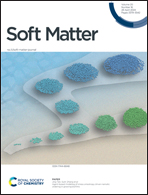Mechanical guidance to self-organization and pattern formation of stem cells†
Abstract
The self-organization of stem cells (SCs) constitutes the fundamental basis of the development of biological organs and structures. SC-driven patterns are essential for tissue engineering, yet unguided SCs tend to form chaotic patterns, impeding progress in biomedical engineering. Here, we show that simple geometric constraints can be used as an effective mechanical modulation approach that promotes the development of controlled self-organization and pattern formation of SCs. Using the applied SC guidance with geometric constraints, we experimentally uncover a remarkable deviation in cell aggregate orientation from a random direction to a specific orientation. Subsequently, we propose a dynamic mechanical framework, including cells, the extracellular matrix (ECM), and the culture environment, to characterize the specific orientation deflection of guided cell aggregates relative to initial geometric constraints, which agrees well with experimental observation. Based on this framework, we further devise various theoretical strategies to realize complex biological patterns, such as radial and concentric structures. Our study highlights the key role of mechanical factors and geometric constraints in governing SCs' self-organization. These findings yield critical insights into the regulation of SC-driven pattern formation and hold great promise for advancements in tissue engineering and bioactive material design for regenerative application.



 Please wait while we load your content...
Please wait while we load your content...